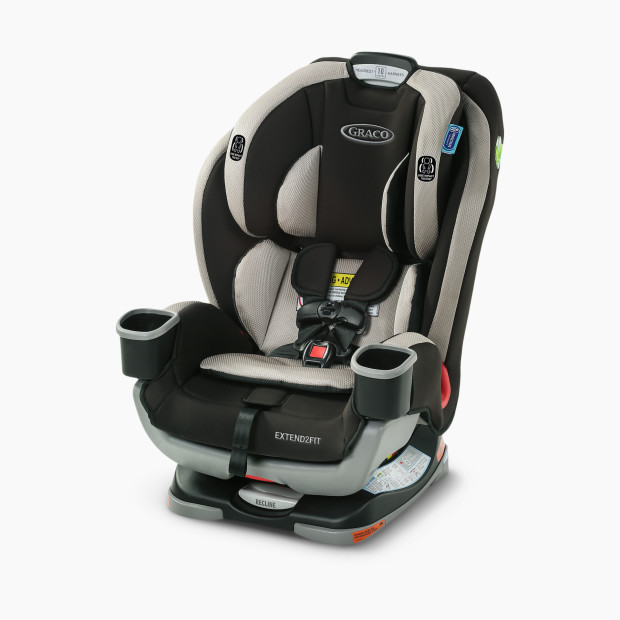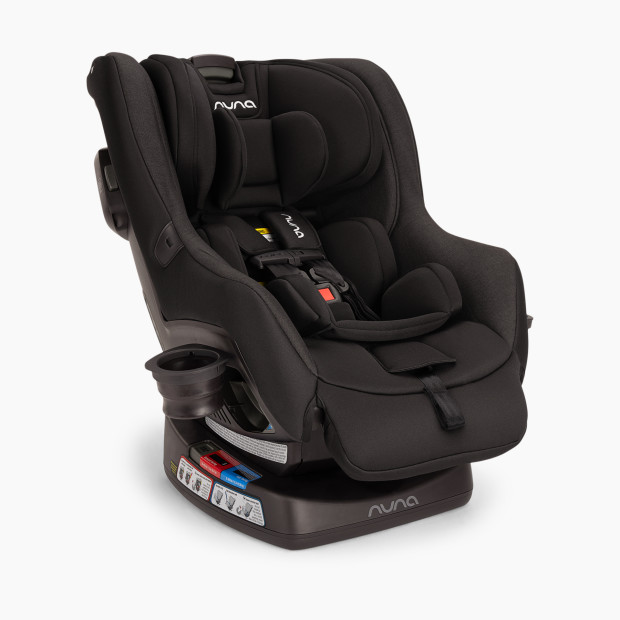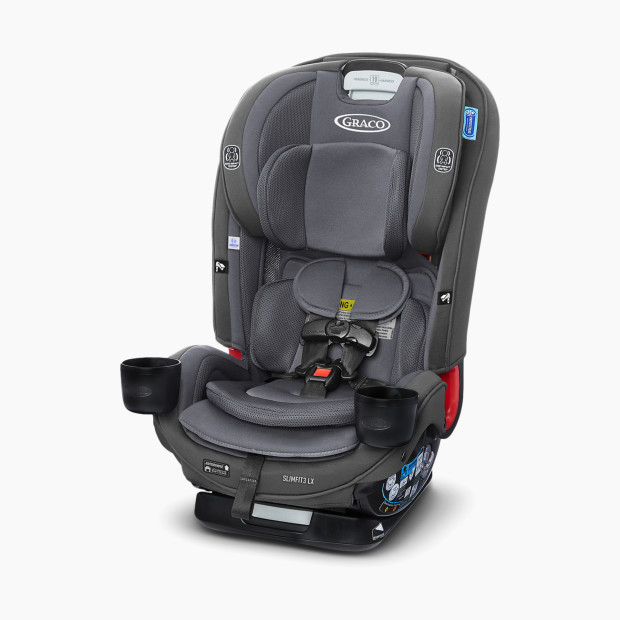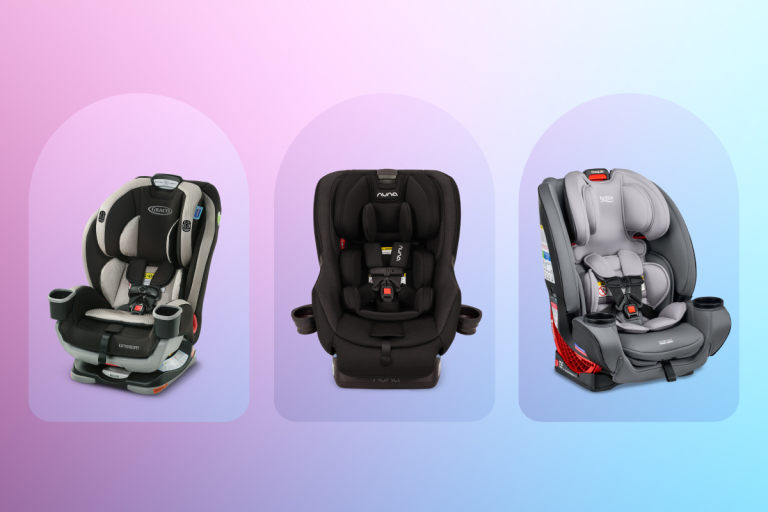
The Best Convertible Car Seats of 2025
You’ll use a convertible car seat for years. Our research and testing will help you find the best one for your family.

In This Article
Choosing the best car seat for your baby or toddler is a big decision. This is especially true when you’re shopping for a convertible seat. Even the best infant car seats only fit babies up to about 18 months at the most; convertible seats, on the other hand, last for years, taking your child from the baby days all the way through elementary school in some cases.
We think Graco’s Extend2Fit 3-in-1 Car Seat is the best convertible car seat for most families. It checks all the boxes: it fits well in almost any type of vehicle (including smaller cars); getting a correct, secure install is quick and easy; and it’s designed to promote extended rear-facing, the safest way for children to ride.
If you need a few more options before you decide what’s the best for your family, we’re giving honorable mention to three additional seats: the Nuna Rava Convertible Car Seat, Evenflo's Revolve 360 Extend All-in-One Rotational Convertible Car Seat and the Britax One4Life ClickTight All-in-One Car Seat.
- Honorable Mention
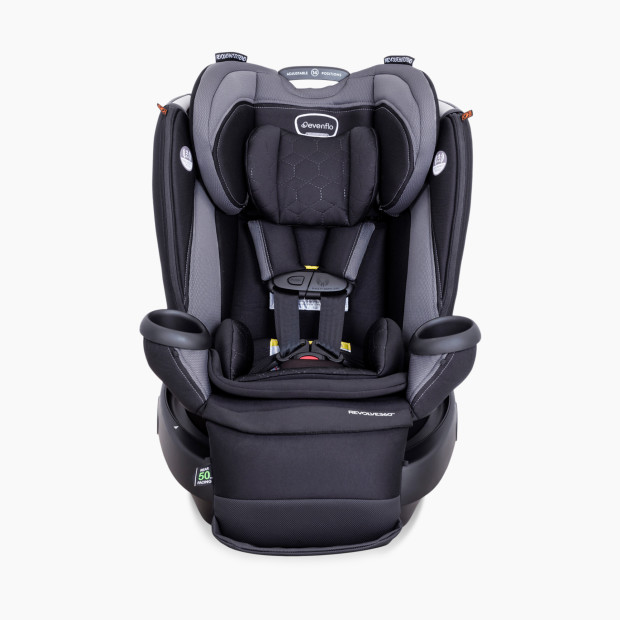 Evenflo Revolve360 Extend All-in-One Rotational Convertible Car Seat - RevereFrom $259.99
Evenflo Revolve360 Extend All-in-One Rotational Convertible Car Seat - RevereFrom $259.99 - Best for Travel
 Cosco Cosco Kids Scenera Next DLX Convertible Car Seat, Moon MistFrom $59.00
Cosco Cosco Kids Scenera Next DLX Convertible Car Seat, Moon MistFrom $59.00 - Safety Extras
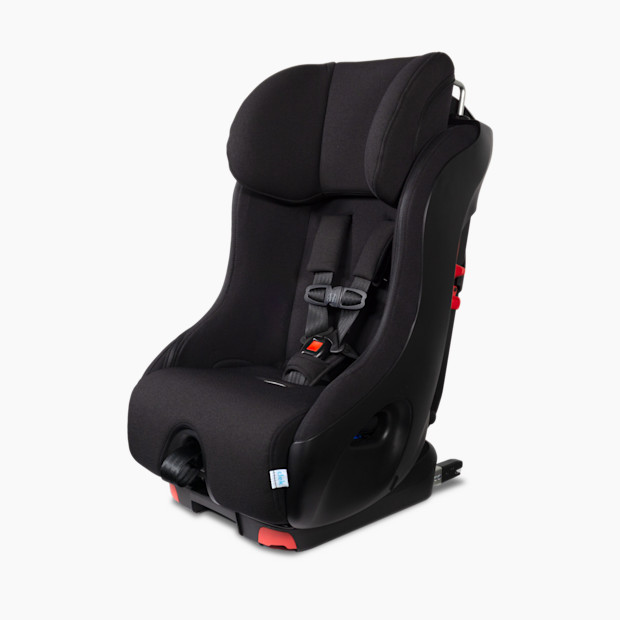 Clek Clek Foonf Convertible Seat - Railroad Ziip (Flame Retardant Free)From $559.99
Clek Clek Foonf Convertible Seat - Railroad Ziip (Flame Retardant Free)From $559.99
Why Trust Babylist?
Babylist is the expert in baby; we know baby gear inside and out. We talk with parents face-to-face in our showroom and on our user panels and hear from thousands annually via our Best Baby Products online survey. We know what items millions of expecting parents are adding to their baby registries.
Firsthand professional and personal experience. As a CPST, I'm specially trained in car seat usage and safety. I've installed dozens of car seats, including many convertible car seats, and am constantly staying up-to-date on car seat education through continuing education classes, seminars and CPST education groups. I'm also Babylist's gear editor; I've been writing about baby gear at Babylist since 2019 and have been the gear editor since 2021. I've personally tested and reviewed dozens of convertible car seats during this time. And I'm a mom of two boys, ages three and ten—so I have over a decade of hands-on car seat experience with my two sons.
Expert POV. I spoke to several experts while researching this guide, including Rebekah Kimminau, Child Passenger Safety technician (CPST) and founder of The Baby Gear Consultant, and Samantha Taylor, CPST, and the voice behind Mama Knows Car Seats. I also spoke with Joe Colella, Director of Child Passenger Safety at the Juvenile Products Manufacturers Association, a leading industry voice on quality and safety for baby and children’s products, and 2020 Child Passenger Safety Hall of Fame Inductee. I also reviewed the latest safety data and recommendations from professional organizations like the American Academy of Pediatrics (AAP) and the National Highway Traffic Safety Administration (NHTSA) and leading voices in child car seat safety such as Safe Kids Worldwide, Car Seats for the Littles, and The Car Seat Lady.
Convertible car seat data. I regularly analyze which baby products our users are adding to their baby registries the most (and which ones they aren’t) and what our team of Merchandising experts—our buyers who are responsible for ensuring the Babylist Shop is stocked with the best and newest gear—is excited about. Studying this kind of data helped us choose which convertible car seats to narrow in on and which ones to recommend to new and expecting parents.
Feedback and reviews. I reviewed comments and feedback from Babylist’s annual product survey of thousands of Babylist parents, read customer reviews from hundreds of Babylist users and spoke to parents on our Babylist staff about their real-life product experiences.
How We Judged
Here’s what to know before you start shopping for a convertible car seat:
While you can use a convertible car seat from birth, most parents choose to start with an infant car seat and transition to a convertible once their child outgrows their infant seat. Convertible car seats are large, heavy and designed to stay put in a vehicle. This makes them less convenient than an infant car seat that clicks in and out of a base and can attach to a stroller. If you’ll be moving your convertible car seat between different cars often or traveling with it frequently, take into consideration how much the seat weighs and how easy it is to install.
A convertible car seat can take you from day one well through the preschool years. Some all-in-one options can even last through elementary school.
All car seats sold in the US must pass the same federal safety standards. While some car seats have extra safety features, that doesn’t always mean those seats are safer. How easy a car seat is to install + how it fits your child also contribute to a car seat’s safety. You can read more on this later in this guide.
Best Convertible Car Seat Overall
Graco Extend2Fit 3-in-1 Car Seat - Stocklyn
From $159.99Pros
- High rear-facing weight limit (50 lbs), so you can rear-face longer
- Fits smaller cars
- Fits all ages of kids well
Cons
- Wide
- Some parents say harness is difficult to tighten
- Seat belt install can take a few tries because of small belt path
This seat has so much going for it: safety, longevity, easy installation, a great fit in all types of cars and extended rear-facing capabilities. Any of these features on its own is impressive, but rolled into one and considering the price, you have a pretty amazing seat that takes you from day one through elementary school.
“The original Graco Extend2Fit is one of the most-loved budget-friendly seats,” says Rebekah Kimminau, CPST and founder of The Baby Gear Consultant. “The 3-in-1 version takes all the beloved features of the original and adds even more to love.”
Babylist parents agree. They consistently praise the Extend2Fit for being “very secure” and like that it grows with your child. They also love the extended rear-facing capability. "It’s so easy to install and the footrest extension gives so much peace of mind as she will be able to comfortably sit rear facing for longer," one Babylist parent told us.
The Extend2Fit generally fits kids of all ages well, from smaller newborns to school-aged kiddos. This 3-in-1 version offers three modes of use—rear-facing, forward-facing harness and high-back booster—so you’ll get years and years of use out of it. My biggest selling point for this seat is its 50-pound weight limit, which lets parents rear-face longer than many other convertible car seats. I also appreciate the extendable leg rest for an extra five inches of legroom to make extended rear-facing more comfortable; I find many older kids will complain less about rear-facing if they’re comfortable. Since the seat can sit almost upright when rear-facing, it allows taller parents like me to still be comfy in the front seat if the car seat is installed behind them.
Parents with compact cars, like sedans or crossover SUVs, particularly like the smaller front-to-back profile of this seat. Just note that since Graco requires the cup holders to be attached when the seat is in use, it is on the wider side—something to keep in mind if you need to fit multiple car seats across your back seat. It will also take up more room front to back when the extension panel is in use. And some parents complain that the straps can be tough to tighten, especially over time.
Additional Specs
Child Guidelines: Rear-facing: 4-50 lbs, top of head must be 1" below headrest adjustment lever; forward-facing: 22-65 lbs, up to 49"; highback booster: 40-100 lbs, 43-57"
Honorable Mentions
Nuna RAVA Convertible Car Seat - Caviar
From $550.00Pros
- Quick, easy install
- High rear-facing weight limit (50 lbs) + an extendable calf rest for added comfort
Cons
- Straps tangle easily
- Expensive
The first thing parents usually notice about the Nuna Rava seat is its good looks. The modern design gives the seat a distinctive look that sets it apart from other convertible car seats on the market. I’m happy to say that the seat’s function lives up to its stylish looks. While pricey, it’s packed with thoughtful features for optimum safety and ease of use.
The Rava has one of the highest height and weight maximums for rear-facing on our best-of list, with a 50-pound weight limit and a 49-inch height max. If you’re a parent of taller kids, like myself, or if you’re looking to maximize the time your child can ride rear-facing, this seat is a great choice. Like the Graco Extend2Fit, an extendable calf rest is attached for even more rear-facing comfort and for forward-facing riders who don’t love their legs dangling without much support. (Speaking of comfort, the seat is ultra plush; many parents rave that the cushioning is really soft and very supportive. All fabric options are also flame retardant free.)
The other feature I value in the Rava is the seamless installation. “Installing the Rava is very easy with either the seat belt or LATCH system,” Kimminau points out. While you can use LATCH, Nuna recommends a seat belt install—and it couldn’t be simpler. Just lift the True Tension door, route your seat belt through the path, tighten and lock the belt then close the door back up. It takes me under 30 seconds and it’s so easy to do; I appreciate that I don’t have to take the manual out each time I need to reinstall the seat.
Thoughtful features are often what set a car seat apart from its competitors, and the Nuna shines here, too. "The best part is the buckle holders making it extremely easy to get the baby in," one parent told us. Others mentioned the retractable cup holders,no-rethread harness and breathable knit fabric with ventilation panels. The fit for this seat is also worth a call-out. There are 10 recline options, making it good for comfort and achieving a proper install in all different types of vehicles.
Additional Specs
Child Guidelines: Rear-facing: 5-50 lbs and up to 49”; forward-facing 30-65 lbs and up to 49”
Evenflo Revolve360 Extend All-in-One Rotational Convertible Car Seat - Revere
From $259.99Pros
- Rotates 360 degrees for easy in and out
- High rear-facing height and weight limitis
- No need to uninstall to switch from rear- to forward-facing
Cons
- Bulky, especially front to back when rear-facing
- Short, flimsy crotch buckle can get wedged under your child
- Newborns and smaller babies may not fit well
Several years ago, most parents hadn’t even heard of a rotating car seat—and now the Evenflo Revolve360 Extend is one of the most frequently added convertible car seats to Babylist registries, with Babylist parents saying it’s a “must-have item” that’s “so easy to install and so easy to use.”
A rotating car seat is a car seat that swivels at the base either 180 or 360 degrees with the touch of a button. Rotating seats make it easier to get your little one in and out of the car, especially when they’re rear-facing. They also make it easier to rear-face your child (the safer way for young children to ride)—and when something is easier, you’re more likely to do it.
The Revolve360 Extend is both a parent and a personal favorite. I love that it supports extended rear-facing (up to 50 pounds or 48 inches) and the anti-rebound bar for added safety. But just as importantly, I love it for how easy it makes getting my wriggly three-year-old in and out of my car daily. The rotation feature works seamlessly—the buttons are easy to access (there’s one on either side of the seat), and I’ve never had the seat get stuck while spinning it. After using it for over a year now, I can’t imagine ever going back to a traditional convertible.
The Revolve360 is built for 10 years of use (rear-facing, forward-facing and high-back booster mode) and, unlike some rotating seats that require you to uninstall and reinstall the seat when you’re making the switch from rear- to forward-facing, you’ll only need to install it once if you use the seatbelt installation method.
This is a taller seat front-to-back, so keep that in mind if you own a compact vehicle. It’s also fairly wide; for a slimmer option, check out the Evenflo Revolve360 Slim.
Additional Specs
Child Guidelines: Rear-facing: 4-50 lbs, 17”-48” tall; forward-facing: 22-65 lbs. 28”-49” tall; booster: 40-120 lbs, 44”-57” tall
Britax One4Life ClickTight All-in-One Car Seat - Onyx
From $279.97Pros
- Works from birth to big kid (about 10 years of use)
- Quick and easy to install
- High weight limits for all stages
Cons
- Straps can be difficult to tighten
- Heavy
- Some parents say crotch buckle is short
An all-in-one car seat is a convertible seat that’s designed to work from infancy through the elementary school years, transforming from a rear-facing to a forward-facing seat and ultimately to a booster.
The Britax One4Life is popular among parents and CPSTs several reasons, but one in particular stands out: installation. It’s “one of the easiest-to-install car seats on the market,” says Kimminau (and I agree) thanks to Britax’s patented ClickTight technology, a system that uses your vehicle’s seat belt and an effort-free belt-tightening system to make it easy to get a proper, secure install every time. And considering that more than half of all car seats are not installed correctly, this is a pretty big deal.
The One4Life is also fairly affordable considering its features. As it’s an all-in-one seat, you’ll be able to use it from infancy through the elementary school years as an infant car seat, then a rear-facing convertible, then a forward-facing convertible and finally as a high-back booster seat. Other safety features include a steel frame, crumple zone and a V-shaped tether to help absorb energy during a crash, as well as two layers of side impact protection.
Just note that the seat is on the heavier side, even when compared to (also heavy) all-in-one seats. And some parents say that the straps can be difficult to tighten and the crotch buckle is on the shorter side, which may interfere with a comfortable fit for some children.
Additional Specs
Child Guidelines: Rear-facing: 5-50 lbs; forward-facing 5-point harness seat: 22-65 lbs; highback booster: 40-120 lbs
Other Car Seats We Love
Looking for a convertible car seat to fill a specific need, like a good option for travel or a slim fit for three across? Here are a few more convertible car seats that rank high on our list.
Best Convertible Car Seat for Travel
Cosco Cosco Kids Scenera Next DLX Convertible Car Seat, Moon Mist
From $59.00Pros
- Ultra lightweight (7.8 lbs)
- Very budget-friendly
- FAA-approved for plane travel
Cons
- Low weight limit (40 lbs)
- Thin cushioning may not be comfy for longer rides
- Takes practice to install correctly
If you travel frequently, you may want to consider a car seat that prioritizes weight. (A lighter car seat is easier to lug around when you’re on the go.) The Cosco Scenera Next is “one of the lightest convertible car seats on the market,” according to Kimminau, weighing in at under eight pounds. It’s been my go-to travel car seat for over a decade and I’ve taken it on more flights than I can count. It’s also extremely affordable. Keep in mind that installation can take some practice.
Additional Specs
Child Guidelines: Rear-facing: 5-40 lbs and 19-40”; forward-facing: 22-40 lbs and 29-43”
Best Convertible Car Seat with Extra Safety Features
Clek Clek Foonf Convertible Seat - Railroad Ziip (Flame Retardant Free)
From $559.99Pros
- Steel frame, anti-rebound bar + many other extra safety features
- Built for extended rear-facing
- Slim enough to fit 3-across
Cons
- High; can block your rear/side view if you’re a shorter driver
- Does not have a no-rethread harness
- Heavy
“Built like a tank” is the most common phrase you’ll hear describing the Clek Foonf—and it’s what people like most about it. This iconic seat is packed with advanced safety features, and while it does come at a price, those features are what drew me to it and why I used it as my primary convertible car seat with my first son. CPSTs agree; Kimminau calls the Foonf a “super solid car seat that provides great extra safety features.”
The Foonf is one of only two convertible car seats in the US with true rigid LATCH. (The other is The Convertible Car Seat from Babyark.) This means you’ll get the absolute tightest installation so your seat will move as little as possible in the event of a crash. It has a steel frame and is built for extended rear-facing for up to 50 pounds; I comfortably rear-faced my taller-than-average son in it well past his fourth birthday without any issue. (Many kids outgrow the Foonf in the forward-facing position around four or five years old due to the seat’s height limit, but that wasn’t the case for us.) There's also an anti-rebound bar and two layers of side-impact protection. And despite its heft, it's one of the slimmest convertible car seats on the market, making it ideal for parents with smaller vehicles or those who need to go three-across in their back seat.
This Railroad Zip version of the Foonf features an easy-on, easy-off zippered cover that can be tossed right in the washing machine—a huge improvement over older models that were much more difficult to clean.
Additional Specs
Child Guidelines: Rear-facing: 14-50 lbs and 25-43”; forward-facing: 22-65 lbs and 30-49”
Best Slim Fit Convertible Car Seat
Graco SlimFit3 LX 3-in-1 Car Seat - Kunningham
From $199.99Pros
- Fits three across in almost any configuration
- Two cup holders
- Steel-reinforced frame + energy-absorbing foam
Cons
- Doesn’t recline as much as some other convertible car seats
- Removable seat covers can be confusing to put back on after washing
- Installation can be tricky
“This is currently the narrowest convertible car seat on the US market, coming in at 16.9 inches wide,” says Kimminau. Like the Clek Foonf, it’s a good choice for families who need to fit multiple car seats across their back seat—at a much more affordable price. “It features a belt lock-off for forward-facing installation, making installation in that mode a breeze. It also converts to a high-back booster seat,” she says.
Additional Specs
Child Guidelines: Rear-facing: 5-40 lbs; forward-facing: 22-65 lbs; highback booster: 40-100 lbs
How to Choose a Safe Convertible Car Seat
“All car seats sold in the US must meet stringent safety regulations following the requirements set by the NHTSA,” explains Colella. So while certain designs, materials and features can contribute to a seat’s safety, durability, convenience or comfort, “a higher price tag does not necessarily equate to more safety.”
But how does that translate to real-life car seat shopping? How do you know which, if any, safety features to prioritize and which ones to skip?
According to Colella, the best car seat for your child meets these criteria:
Fits your child. The seat you choose should meet your child’s height, weight, age and developmental needs.
Fits your vehicle. The car seat must be correctly installed in the vehicle to perform its functions. “Following car seat installation instructions and vehicle owner’s manual guidance is crucial.”
Used consistently and correctly. You—and anyone else who consistently drives with your child—need to know the ins and outs of your seat and be comfortable using it correctly, says Colella.
These three things—how a car seat fits your child, how easy it is to install it in your car and how easy it is to use day in and day out—are inextricably linked to a car seat’s safety. You can buy a seat with every extra safety feature imaginable, but if it’s impossible to install or doesn’t fit well in your car, the extra bells and whistles don’t matter a bit.
Car seat fit
One of the most common questions we get from parents when they’re researching convertible car seats is around fit, especially since it’s nearly impossible to try out multiple car seats in your vehicle before you decide. Here’s what we recommend:
Measure. This sounds obvious, but we can’t stress just how important this simple step is when you’re researching and comparing car seats. Before committing to a seat, look up the seat’s dimensions, then break out the measuring tape and spend a few minutes in your car. If you have a compact car, pay attention to the seat’s height and depth measurements. If fitting multiple car seats across your back seat is your concern, focus on the car seat’s width measurements. It’s not an exact science, but it’s a good starting point to get you a rough estimate of what fit might look like in your particular vehicle.
Check if the car seat can touch the front seat. A convertible car seat’s front-to-back measurement and the angle required for a proper installation both can affect how a car seat fits into a back seat. A tall, deep seat with fewer recline options can cause an issue if you drive a smaller, more compact vehicle or if you’re tall and need space to push your front seat back. One way to solve this is to research if the particular brand of seat you’re interested in allows for a rear-facing car seat to touch the vehicle seat in front of it. Most manufacturers allow a car seat and a front seat to lightly touch, but some require an inch or two of clearance between the two. (And even within the manufacturers that do allow the seats to touch, there are very specific—and differing—guidelines brand by brand. Here are Graco’s guidelines, for example, versus Clek’s.) You can search and download a manufacturer’s car seat manual to check guidelines around this before you purchase.
Pay attention to recline. Recline does more than just allow your child to ride comfortably in their seat; it also affects how a seat fits in the back seat once it’s installed. In general, a car seat with more recline options will fit a wider range of vehicles. But like all things with car seats, this isn’t always the case—so don’t use this as your only fit predictor.
Convertible car seat safety features
The experts we spoke to recommend considering these safety features when choosing a convertible car seat:
Alert systems: Some car seats have built-in sensors designed to warn the driver of an unsafe situation, such as if a child is accidentally left behind in the car.
Anti-rebound bar: A car seat will move toward the point of impact during a crash. An anti-rebound bar reduces the movement of the seat during a collision, halting the seat’s rebound and causing it to come to a stop sooner than it would have without the bar.
Higher rear-facing height and weight limits: A growing body of research proves riding rear-facing is safer for babies and children than riding in a forward-facing car seat. If possible, always choose a convertible seat that has high rear-facing height and weight limits so you can extend the opportunity to rear-face as long as possible.
Safety indicators: Some car seats come with built-in leveling systems and indicators to signal they’ve been correctly installed.
Side impact protection: “Enhanced side impact protection features can improve child safety in crashes from more directions,” explains Colella. All car seats manufactured after June 30, 2025, will be required to meet side impact performance regulations, but some models already have features built in that have been crash-tested for improved outcomes.
Vehicle fit: Car seats range in size and shape, and so do vehicles and back seats. Be sure the convertible car seat you choose fits properly in your vehicle.
Convertible car seat convenience features
There are also convenience features to think through when shopping for a convertible car seat. Here are the ones you should pay the most attention to:
Convenience extras: Most parents use their convertible car seat for years—which means a lot of getting your kiddo into and out of whichever seat you choose. Think through ease-of-use features like cup holders, buckle holders, a no-rethread harness and cushioning when you’re comparing car seats. Also pay attention to how easy it is (or isn’t) to adjust the harness and clip and unclip the buckles.
Ease of installation: Convertible car seats aren’t designed to be moved around frequently, so most parents buy one for each vehicle and only uninstall their seats if absolutely necessary. Regardless, a seat that’s easier to install will save you time and will increase the chance that the seat is installed correctly. Many car seats can be installed using either LATCH (available in cars made after 2002) or a vehicle’s seat belt. Just be sure you’re still within the weight limits of your car seat’s LATCH restrictions and remember to switch over to a seat belt install once you exceed them.
Fabric: Besides looking for fabric that matches your style, consider its durability. Also consider if you prefer a car seat with removable, washable seat covers or if you’re okay with fabric that’s spot-clean only. If you’re conscious of chemical emissions, you may want to prioritize seats that are GREENGUARD Gold Certified.
Longevity: Most convertible car seats will last until your child is at least four or five years old, but some, called all-in-one car seats, are designed to last almost a decade by converting from a rear-facing seat to a forward-facing seat and ultimately to a booster. There are pros and cons to these types of seats and no “right” choice—it’s all about figuring out what works best for your family.
What You Need To Know About Convertible Car Seats
What is a convertible car seat?
A convertible car seat can be used with children of various sizes and can change from a rear-facing to a forward-facing seat. (The term “convertible” references this rear-to-forward switch.) A convertible seat starts in a rear-facing position for babies and toddlers and is then turned forward-facing as your child gets older. These seats can take you from day one through the preschool years and beyond. Some convertibles even turn into booster seats for school-age kids.
When do you need a convertible car seat?
You’ll need a convertible car seat at some point—but it’s a personal preference as to when.
Some parents use a convertible car seat from day one. Others choose to use an infant car seat initially and then make the switch to a convertible car seat when their little one has reached the seat’s height or weight maximum, usually around their first birthday.
This is because convertible car seats aren’t nearly as portable as infant seats. Unlike infant car seats that are installed into a base and designed to click in and out of your car, convertible seats install directly into your vehicle using either the car’s LATCH system or seat belt and stay there.
There’s also fit to consider. “For most parents, an infant car seat is the right choice for a first car seat,” explains Taylor. “Not all convertible car seats offer the most snug fit or best recline for tiny newborns. There are a few that do, but far and away the newborn fit of an infant seat is more consistent,” she explains.
If you opt for a convertible car seat from day one and your little one frequently rides in more than one vehicle, we recommend purchasing a convertible seat for each car.
When to switch from an infant car seat to a convertible
You’ll need a convertible car seat at some point—but it’s a personal preference as to when.
Some parents use a convertible car seat from day one. Others choose to use an infant car seat initially and then make the switch to a convertible car seat when their little one has reached the seat’s height or weight maximum, usually around their first birthday.
This is because convertible car seats aren’t nearly as portable as infant seats. Unlike infant car seats that are installed into a base and designed to click in and out of your car, convertible seats install directly into your vehicle using either the car’s LATCH system or seat belt and stay there.
There’s also fit to consider. “For most parents, an infant car seat is the right choice for a first car seat,” explains Taylor. “Not all convertible car seats offer the most snug fit or best recline for tiny newborns. There are a few that do, but far and away the newborn fit of an infant seat is more consistent,” she explains.
If you opt for a convertible car seat from day one and your little one frequently rides in more than one vehicle, we recommend purchasing a convertible seat for each car.
What to know about extended rear-facing
Many car seats call out “extended rear-facing” as a benefit of their particular seat. It’s a term you should understand as you shop for a convertible car seat.
“According to the AAP and NHTSA, it's safest for infants and toddlers to ride rear-facing in a car seat for as long as possible,” explains Colella. “This recommendation is based on data showing that rear-facing seats offer better protection in crashes for children from birth through 23 months of age, along with child development and biomechanics considerations.”
When used to describe a feature of a convertible car seat, extended rear-facing refers to a seat that allows a child to maximize the amount of time they can ride rear-facing by offering higher weight and height limits. Car seat experts, the AAP and the NHSTA all agree on the many benefits of extended rear-facing. Whenever possible, it’s recommended to keep your child rear-facing in their convertible car seat until they reach the top height or weight limit allowed by your seat’s manufacturer. But know that your child is safe as long as you use your seat according to the instructions, says Colella.
“Convertible and all-in-one car seats feature weight and height ranges that allow for either rear-facing or forward-facing use. These ranges are determined through extensive manufacturer testing and meet strict safety standards,” explains Colella. “A car seat might allow rear-facing from five to 40 pounds and forward-facing from 30 to 65 pounds, for example. This overlapping range accommodates variations in children's sizes, body proportions and developmental needs, and either mode is safe for that model when used according to manufacturer instructions.”
What to know about LATCH
LATCH is a safety system designed to secure child car seats in vehicles. (LATCH stands for Lower Anchors and Tethers for Children.) The system consists of two lower anchors and a top tether (a strap) that connect the child seat to the vehicle. The lower anchors are attached to the vehicle’s anchor points, usually located in the back seat, while the top tether is attached to a designated anchor point on the back of the vehicle’s seat.
LATCH provides an easier way to install a car seat compared to using a seat belt, and can sometimes help you get a more secure installation. But it’s not always the safer way. (The Car Seat Lady’s LATCH system explainer does a great deep dive into this if you want to learn why.) Using LATCH to install a car seat is also predicated on meeting certain weight limits. Once you exceed those limits, you’ll need to switch over to using your car’s seat belt for installation. Always be sure to consult your car seat manual and follow the manufacturer’s instructions when installing and using your convertible car seat.
Convertible Car Seat Frequently Asked Questions
Are used car seats safe?
We don’t recommend using a secondhand car seat. That’s because you can never be sure of a car seat’s past. A used convertible car seat may have sustained damage in a crash or from being dropped or may not meet current safety regulations.
If you do select a used car seat, get it from someone you trust. Be sure to look up the seat’s expiration date and research if that particular model has ever been recalled. If the seat is dirty, strictly follow the manufacturer’s rules on how to clean the car seat to maintain its integrity.
Do convertible car seats work with strollers?
This is one of the most popular questions new parents have about convertible car seats and, unfortunately, the answer is generally no. (If you want to see what infant seats work with which strollers, check out Babylist’s Infant Car Seat and Stroller Compatibility guide.)
The only convertible car seat currently on the market that’s compatible with a stroller is the Orbit Baby G5 Toddler Car Seat. There are lightweight travel car seats, but the inconvenient reality is that once your little one outgrows their infant seat, you’ll lose the ability to easily transfer their seat from the car directly onto your stroller.
How many years are convertible car seats good for?
Convertible car seats typically last six to ten years, depending on the specific model and manufacturer’s guidelines. However, it is important to regularly check the seat for signs of wear and tear and replace it if necessary. Additionally, it is recommended to follow the height and weight limits for each stage of the seat to ensure maximum safety for your child.
Do all convertible car seats fit in all cars?
Not all convertible car seats fit in all cars. Before purchasing or registering for a convertible car seat, check the seat’s specifications and compare them to the dimensions and features of your vehicle’s back seat. Some car seats are designed to fit better in certain types of vehicles, such as smaller cars or larger SUVs.
What is the safest spot for a convertible car seat?
According to car seat safety experts, the safest spot for a convertible car seat is in the center of the back seat of a vehicle. This position offers the most protection from side impact crashes and reduces the risk of injury in the event of a collision. But it’s not always possible to install a car seat in the middle seat. If the center position isn’t an option, choose the spot where you can install it tightly using either LATCH or your vehicle’s seat belt, according to the AAP’s car seat safety information guidelines. And always check your specific vehicle’s owner’s manual before installation. The Safe Kids’ Ultimate Car Seat Guide Installation Tips is a great resource for car seat installation.
At what age should a child transition to a booster seat?
According to the AAP, children should transition to a booster seat when they reach the maximum height or weight of their forward-facing car seat. Car seat experts emphasize that children must be mature enough to sit properly in a booster seat before making the switch. (Sitting upright, no leaning, twisting or reaching, etc.) Many children aren’t mature enough to make the switch until at least five years old; most hit this milestone sometime between five and seven.
